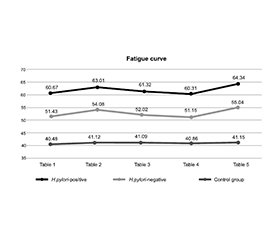Международный неврологический журнал Том 20, №2, 2024
Вернуться к номеру
Нейропсихологічні й психометричні показники при виразковій хворобі дванадцятипалої кишки залежно від наявності в пацієнтів Helicobacter pylori
Авторы: O.V. Tkachenko, O.V. Demydas, O.M. Kononets, L.Yu. Lichman
Shupyk National Healthcare University of Ukraine, Kyiv, Ukraine
Рубрики: Неврология
Разделы: Клинические исследования
Версия для печати
Мета: дослідження впливу Helicobacter pylori (H.pylori) при виразковій хворобі дванадцятипалої кишки (ВХ ДПК) на нейропсихологічні та психометричні показники. Матеріали та методи. Проведено комплексне клініко-неврологічне, нейропсихологічне й психометричне обстеження 60 пацієнтів із ВХ ДПК. Вік обстежених осіб коливався від 25 до 60 (у середньому 39,80 ± 1,29) років. Усі пацієнти були поділені на дві групи за ознакою наявності інфекції H.pylori (група 1) чи її відсутності (група 2). Контрольну групу становили 30 практично здорових осіб без соматичної патології. Для дослідження психометричних і нейропсихологічних характеристик проведено комплексне тестування, яке включало визначення рівнів депресії за шкалою Бека, конституційної та реактивної тривожності за шкалою Спілбергера — Ханіна, оцінку самопочуття, активності та настрою за опитувальником WAM, когнітивних порушень за шкалою MMSE, швидкості переключення уваги та динаміки працездатності за допомогою таблиць Шульте. Результати. У пацієнтів із H.pylori-позитивною ВХ ДПК рівень депресії був вірогідно вищим, ніж при H.pylori-негативній ВХ ДПК (p < 0,05). У групі 1 виявлені більш високі показники особистісної і реактивної тривожності та нижчі показники функціонального стану. Також у цих пацієнтів за допомогою таблиць Шульте встановлено зниження концентрації уваги. Зафіксовано прямий кореляційний зв’язок між ступенем депресивних розладів та кількістю скарг, пов’язаних із психоемоційними розладами, у пацієнтів із ВХ ДПК (r = 0,61). Зворотний кореляційний зв’язок виявлений (p < 0,05) між рівнем тривожності й показниками опитувальника WAM і між депресивними розладами та даними WAM у пацієнтів із ВХ ДПК. У 73,3 % випадків у першій та в 30 % в другій групі депресія і тривога були коморбідними. Висновки. Скарги, пов’язані з психоемоційними розладами, зустрічалися в пацієнтів як з H.pylori-позитивною, так і з Н.pylori-негативною ВХ ДПК, однак частіше в групі 1. Прояви депресії зафіксовано в обох групах, але її рівень був вірогідно вищим у пацієнтів із H.pylori-позитивною ВХ ДПК (p < 0,05). Зростання тривожності також відмічено в обох групах, утім, показники особистісної та реактивної тривожності були вищими в групі 1. При загостренні ВХ ДПК незалежно від наявності інфекції H.pylori спостерігалося значне зниження активності, погіршення самопочуття та настрою пацієнтів. У групі із H.pylori-позитивною ВХ ДПК зафіксовано нижчі показники само-оцінки функціонального стану. За допомогою таблиць Шульте ми виявили більше зниження концентрації уваги в групі 1, ніж у пацієнтів із H.pylori-негативною ВХ ДПК. Таким чином, за даними нейропсихологічного та психометричного тестування виявлено, що інфікованість H.pylori не є основною причиною психоемоційних розладів у пацієнтів із ВХ ДПК, але за її наявності мають місце більш виражені показники дисфункції. Зокрема, це стосувалося збільшення частоти скарг психоемоційного спрямування, погіршення оцінки рівня самопочуття, підвищення рівня тривожності та посилення депресивних розладів.
Background. The purpose was to study the effect of Helicobacter pylori (H.pylori) in duodenal ulcer on the neuropsychological and psychometric scores. Materials and methods. We conducted a comprehensive clinical, neurological, neuropsychological, and psychometric examination of 60 patients with duodenal ulcer aged 25–60 (the mean of 39.80 ± 1.29) years. All of them were divided into two groups considering whether H.pylori infection was detected (group 1) or not (group 2). The control group included 30 apparently healthy individuals with no somatic abnormalities. To study psychometric and neuropsychological characteristics, the patients were comprehensively tested, in particular using the Beck Depression Inventory for evaluating the severity of depression, the State-Trait Anxiety Inventory for assessing separate dimensions of state and trait anxiety, the Well-being, Activity, Mood (WAM) questionnaire, the Mini-Mental Health Examination for screening cognitive function, the Schulte tables for evaluating the refocusing speeds and performance distribution. Results. The level of depression in H.pylori-positive duodenal ulcer was significantly higher than with H.pylori-negative duodenal ulcer (p < 0.05). The patients from the group 1 had higher scores of state and trait anxiety and the lower ones of the functional state. The concentration of attention detected by means of the Schulte tables was lower in these patients. A direct correlation was found between the degree of depressive disorders and the number of complaints associated with psycho-emotional disorders in the patients with duodenal ulcer (r = 0.61). We found an inverse correlation (p < 0.05) between the anxiety level and the WAM indices, on the one hand, and between depressive disorders and the WAM indices, on the other hand, in the patients with duodenal ulcer. Depression and anxiety were comorbid in 73.3 % of cases in the group 1 and in 30 % of cases in the group 2. Conclusions. The complaints associated with psycho-emotional disorders occurred in the patients with both H.pylori-positive and H.pylori-negative duodenal ulcer; however, they were more frequent in the group 1. The clinical presentations of depression were observed in both groups, but the depression level was significantly higher in the patients with H.pylori-positive duodenal ulcer (p < 0.05). An increase in anxiety was also found in both groups; however, the rates of state and trait anxiety were higher in the group 1. At duodenal ulcer exacerbation, no matter if H.pylori infection was present or not, the patients had unsatisfactory well-being, low activity, and poor mood. The decreased indices of the functional state self-assessment were detected in the group with H.pylori-positive duodenal ulcer. Using the Schulte tables, we found that a decrease in attention concentration was more evident in the group 1 that in the patients with H.pylori-negative duodenal ulcer. Thus, having conducted the neuropsychological and psychometric testing, we conclude that H.pylori infection has not been the main cause of psycho-emotional disorders in duodenal ulcer, but if the patients were infected, the dysfunction was more severe. It was subject to the increased frequency of psycho-emotional complaints, the deterioration in the patients’ sense of well-being, the increased levels of anxiety and depressive disorders.
виразкова хвороба дванадцятипалої кишки; депресія; тривожність; інфекція Helicobacter pylori
duodenal ulcer; depression; anxiety; Helicobacter pylori

